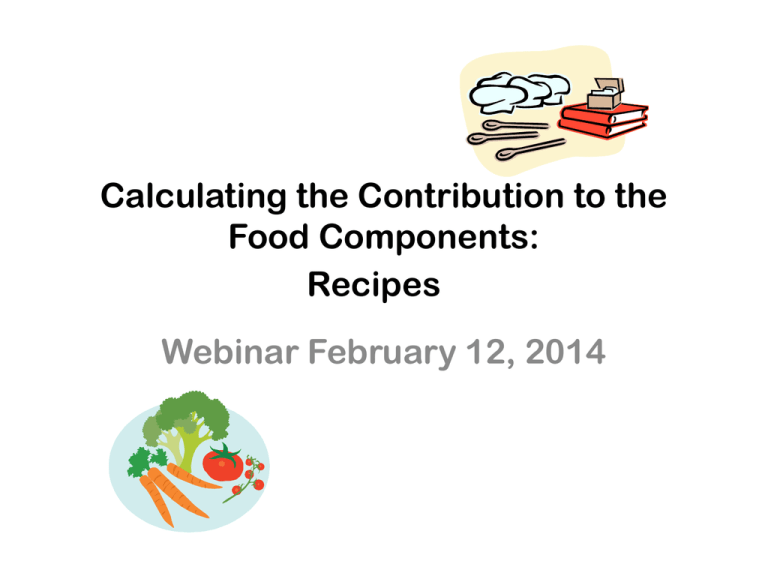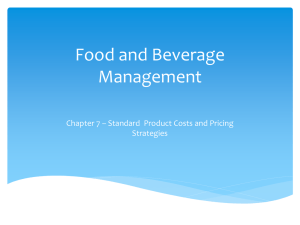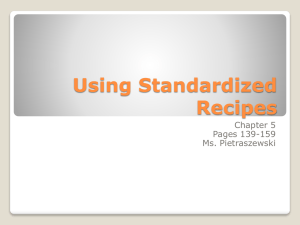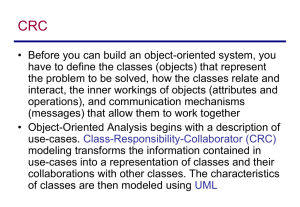includes Webinar presenter script - UC Davis Center for Nutrition in
advertisement

Calculating the Contribution to the Food Components: Recipes Webinar February 12, 2014 Brought to You By: Recipes Purpose of the Webinar • Reinforce the importance of meeting the meal pattern with standardized recipes • Learn why we calculate the contribution of foods in a standardized recipe toward the food components • Show the steps to correctly credit the ingredients in standardized recipes to the food components Recipes Organization of the Webinar Tools to Document the Contribution of Foods to the Meal Pattern Calculating the Creditable Contribution of Ingredients in Recipes Example Recipe Calculation Changing Ingredients or the Contribution of an Ingredient Summary Recipes TOOLS TO DOCUMENT THE CONTRIBUTION OF FOODS Recipes Tools for Crediting Food Components 1. Food Buying Guide 2. Nutrition Facts Label 3. Child Nutrition (CN) Label 4. Product Formulation Statement (PFS) 5. Standardized Recipe Tools for Crediting Food Components 1. The Food Buying Guide (FBG) is the basis for calculating the contribution of: Recipes a. Individual foods b. Standardized recipes c. Processed convenience foods with product formulation statements Food Buying Guide The Food Buying Guide (FBG) is being revised. Sections completed are: • Meat/Meat Alternates • Vegetables/Fruits Recipes To download the latest edition of the revised sections, go to: http://origin.www.fns.usda.gov/tn/resources/fbg_ schoolmeals.html Food Buying Guide Used to determine: • Amount of food to purchase • Amount to prepare • Amount to serve, or serving size Recipes Divided into sections: • Introduction • Meats/Meat Alternates • Vegetables/Fruits (same section, but separate) • Grains/Breads (now called Grains) • Milk • Other Foods • Appendices Food Buying Guide Information in the columns: Specific information on the type and form. Purchase unit for the type and form. Number of servings in each purchase unit. Serving size to provide component credit. Amount to purchase for 100. Edible portion after peeling, cooking, drained or otherwise converted from Column 1 form. Recipes 1. 2. 3. 4. 5. 6. Food Buying Guide Example: Contribution of Leafy Greens Recipes • • Remember when looking at leafy greens, they credit as ½ the volume Remember when you serve with dressing, the yield in Col. 3 changes It’s not in the Food Buying Guide! If a vegetable or fruit is not in the FGB: 1. Prepare the item as it will be served 2. Measure the volume for the quantity to be served 3. Determine the AP amount required to provide that contribution 4. Document your process and use that AP quantity in your recipe Food Buying Guide Calculator Recipes • A calculator tool has been developed by the National Food Service Management Institute that can save you time and effort. • http://Fbg.nfsmi.org/ Tools for Crediting Food Components Recipes 2. Nutrition Facts labels specify the weight of the serving size, particularly for grains and breads, and allow us to use the FBG to determine the contribution of the item. Tools for Crediting Food Components 3. Child Nutrition (CN) labels are issued by USDA and warranty the contribution of the product. The CN logo (which is a distinct border) The meal pattern contribution statement A 6-digit product identification number USDA/FNS authorization statement The month and year of approval. Recipes A CN label will always contain the following: Tools for Crediting Food Components 4. A Product Formulation Statement (PFS) gives us the information to determine the contribution of the ingredients by using the FBG. Recipes Tools for Crediting Food Components Recipes 5. Standardized recipes give the serving size, yield, and list the ingredient information needed to apply the FBG to calculate the contribution of those ingredients. Standardized Recipes Standardized recipes have the following parts: • • • • • • • Recipe name Recipe category Number of the recipe (Optional) Ingredient list Weight and/or measure of ingredients Alternate ingredients or recipe variations (Optional) Directions for preparation Recipes Standardized Recipes Standardized recipes have the following parts: • • • • • • • • Cooking temperature Time for cook, prep, assembly HACCP Critical Control Points Pan, container size, or special equipment Portion size and tool for serving Number of servings Contribution to the meal pattern Recipe yield in weight or volume Other Optional Parts: Nutrients and Marketing guide Blank forms can be downloaded from http://www.education.ne.gov/ns/forms/nslpforms/Recipes.html Recipes CALCULATING THE CREDITABLE CONTRIBUTION OF INGREDIENTS IN RECIPES Recipes Recipes When to calculate the contribution of foods • USDA recipe is revised • School recipe is developed Recipes • School recipe is revised • New recipe is used from outside source Food Buying Guide Appendix A: Recipe Analysis Use to calculate the contribution of ingredients in recipes. Watch for a new release. Check out the CDE Excel template that can be used instead of paper and pencil. Recipe Analysis Steps 1. 2. 3. 4. 5. 6. 7. 8. 9. List ingredients. Record AP weight or volume. Record purchase units. Record the number of servings per purchase unit. Calculate the M/MA contribution. Calculate the V and F contribution. Calculate the G contribution. Record the portions per recipe. Record the final rounded down calculated crediting answers. Recipe Analysis Step 1: List the Ingredients Your Recipe Name Your# Your Recipe Name Your# Recipe Analysis Step 2: Enter the quantity of each Ingredient “as purchased” Your Recipe Name Your# Recipe Analysis Step 3: Enter the purchase unit of the ingredients Your Recipe Name Your# Recipe Analysis Step 4: Enter the servings per purchase unit from the FBG Your Recipe Name Your# Recipe Analysis Step 5: Calculate the M/MA Your Recipe Name Your# Recipe Analysis Step 6: Calculate the V and F Your Recipe Name Your# Your Recipe Name Your# Recipe Analysis Step 7: Calculate the G Your Recipe Name Your# Recipe Analysis Steps 8 and 9: Totals calculated, portions entered, and portion contribution calculated EXAMPLE RECIPE CALCULATION Recipes Orange Couscous Salad Recipe Contribution to the Fruits Component Recipes Orange Couscous Salad Recipe Where’s the Fruit? The recipe contains canned mandarin oranges, raisins and lemon juice, but the contribution is not listed. For 100 servings: • 6 lbs. of drained mandarin oranges .61 lb yield per lb x 7.3 servings/lb = 4.45 servings/lb drained 6 lbs. x 4.45 servings/lb. = 26.7 – ¼ cups Recipes • 2 quarts of raisins 2 quarts = 2 x 4 c x 4 – ¼ c = 32 – ¼ cups Credits as 2 x quantity = 2 x 32 = 64 – ¼ cups Orange Couscous Salad Recipe Where’s the Fruit? • 3 cups of lemon juice 3 cups = 3 x 4- ¼ cups = 12 – ¼ cups Recipes • Total of all Fruits 26.70 + 64 + 12 = 102.7 Divide by 100 servings = 1.02 – ¼ cups Round down to ¼ cup Fruits per serving Orange Couscous Salad Recipe Keep checking: Vegetables • 13 lbs. Chickpeas (Beans, Garbanzo), drained 13 lbs. x 16 oz. = 3.04 #10 cans 68.4 oz. yield per Col. 6 3 #10 cans x 42 servings per #10 can = 126 – ¼ cup which rounds down to: 1 oz eq M/MA or ¼ cup Dry Beans/Peas Vegetable Orange Couscous Salad Recipe Keep checking: Vegetables • 7 cups Diced Onion 7 cups x 4 – ¼ cups per cup = 28 – ¼ cup servings Or to convert the recipe to pounds of whole onions to use: 28 – ¼ cups= 3.01 lb - round down to 3 lb 9.30 - ¼ cups per lb 3 lb x 9.30 = 27.9 – ¼ cups, which we must round down to 27 – ¼ cups Orange Couscous Salad Recipe Keep checking: Vegetables • Total of all Vegetables (counting chickpeas as a vegetable) 126 + 27 = 153 – ¼ cup servings for 100 Divide by 100 servings = 1.53 – ¼ cups 1.53 x .25 = .382 cups Round down to .375 or 3/8 cup vegetables per serving Orange Couscous Salad Recipe Keep checking: Grain The recipe contains couscous, whole wheat, dry and the contribution is listed a 1 grain/bread, or 1 oz eq. For 100 servings: • Recipes 5 quarts of couscous, dry, Group H, 1 oz eq = ½ cup cooked 5 qt x 4 = 8.42 lbs 2.375 cups/lb 8.42 lbs. x 14.5- ½ cup servings/lb. = 122.09 – ½ cups 122.09 ÷ 100 = 1.22 – ½ cups Round down to ½ cup = 1 oz eq Orange Couscous Salad Recipe What Did We Learn? • Validate before you use an outside source recipe! • Write the information on the recipe • Sign and date it CHANGING INGREDIENTS AND/OR THE CONTRIBUTION Recipes Changing Ingredients: M/MA Recipes • • • • Beef Round Steak to 85/15 Ground Beef Recipe: 20 lbs. Round Steak for 100 servings 20 lbs. x 11.2 = 224 ÷ 100 servings = 2.24 oz eq M/MA Round down to 2 oz eq Changing Ingredients: M/MA Desired contribution: 2 oz eq M/MA minimum 1 oz eq per lb = 12 servings per pound Desired contribution for recipe = 200 oz eq 200 oz eq = 16.66 lbs or round up to 17 lbs. 12 servings per pound Note: If the fat % is different, the servings per Purchase Unit will be different Recipes • • • • Changing Ingredients: V or F Recipes • • • • Frozen Apricots, sliced to Fresh Peaches, sliced Recipe: 28 lbs. Frozen Apricots for 100 servings 28 lbs. x 7.26 = 203 ÷ 100 servings = 2.03 – ¼ cups 2 x ¼ cup = ½ cup Changing Ingredients: V or F Desired contribution: ½ cup fruit ¼ cup = 12 servings per pound Desired contribution for recipe = 200 - ¼ cups 200 ¼ cups = 18.69 lbs or round up to 19 lbs. 10.7 servings per pound • 19 lbs x 10.7 = 203.3 – ¼ cups Recipes • • • • Changing Ingredients: Grains From Whole Wheat Bread to Croissant • Are the two items in the same group? • Whole wheat bread is in Group B and 1 oz eq weight is 1 oz • Croissants are in Group C and 1 oz eq = 1.2 oz Changing Ingredients: Grains • 2 slices whole wheat bread = 2 oz or 2 oz eq • For 2 oz eq of croissant: 2 oz eq x 1.2 oz per oz eq (Group C) = 2.4 oz. • Divide the weight of your croissant by 1.2 oz. 3 oz ÷ 1.2 = 2.5 oz eq grains • Is your croissant whole grain-rich? Changing the Contribution: M/MA 85/15 ground beef • The recipe is for 100 and 12.5 lbs 1.5 oz eq M/MA • Want 2 oz eq M/MA • 2 oz eq x 100 servings = 200 oz eq Changing the Contribution: M/MA 85/15 ground beef • 200 oz eq ÷ 12 oz eq per lb = 16.67 lbs, or round up to 16.75 lb • Or 2 x 8.4 lbs (Col 5) = 16.8 lbs • To check: 16.75 lbs x 12 oz eq per lb = 201.0 oz eq • Or 16.8 lbs x 12 = 201.6 oz eq Changing the Contribution: V or F Tomatoes, canned, whole • The recipe is for 100 and 2.25 #10 ¼ cup of tomatoes • Want 3/8 cup Red/Orange vegetable • 3/8 ÷ 1/4 = 1.5 x 100 = 150 – ¼ cup servings per 100 Changing the Contribution: V or F Tomatoes, canned, whole • 150 – ¼ cup servings = 3.30 #10- round up to 3.33 45.5 – ¼ cup servings/#10 can Or • 2.25 # 10 x 1.5 = 3.375 # 10 • To check: 3.33 x 45.5 = 150.15, 3.5 x 45.5 = 159.25 Changing the Contribution: Grains Spaghetti • The recipe is for 100 and 12 lbs 1.25 oz eq G • Want 2 oz eq G • 2 oz eq serving x 100 = 200 oz eq for 100 Changing the Contribution: Grains • 200 oz eq = 18.87 lbs or 19 lbs 10.6 ½ cup servings per lb • To check: 19 lbs x 10.6 = 201.4 oz eq (1/2 cups) for 100 servings SUMMARY Recipes Summary Calculate the food components in a recipe whenever a: • USDA recipe is revised • School recipe is developed • School recipe is revised • New recipe is used from outside source Summary To calculate the food components, use: • The FBG Food Component Sections • Appendix A of the FBG or • The CDE Spreadsheet or • A calculator and paper Summary To change an ingredient or its contribution use: • The FBG Food Component Sections • A calculator and paper Conclusion • Thank you for joining our webinar.







